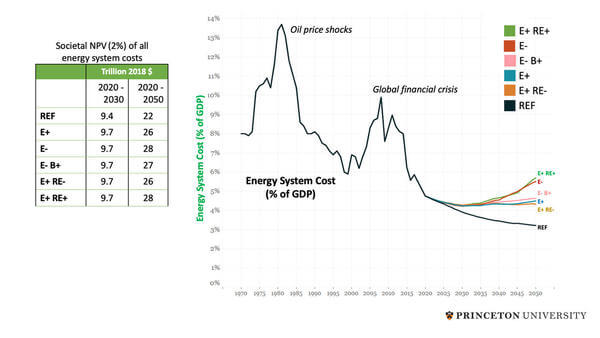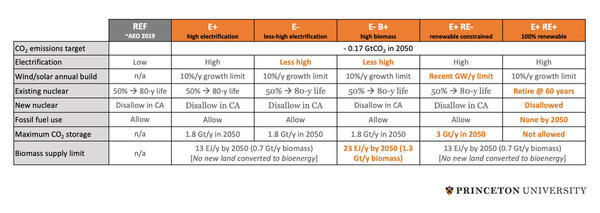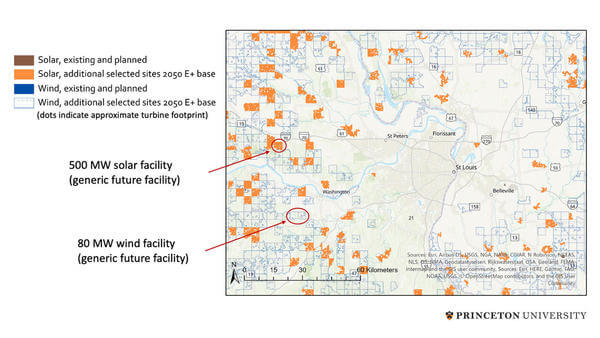Big but affordable effort needed for America to reach net-zero emissions by 2050, Princeton study shows
The new "Net-Zero America" research outlines five distinct technological pathways for the United States to decarbonize its entire economy. The research is the first study to quantify and map with this degree of specificity, the infrastructure that needs to be built and the investment required to run the country without emitting more greenhouse gases into the atmosphere than are removed from it each year. It’s also the first to pinpoint how jobs and health will be affected in each state at a highly granular level, sometimes down to the county.
The study’s five scenarios describe at a highly detailed, state-by-state level the scale and pace of technology and capital mobilization needed across the country, and highlight the implications for land use, incumbent energy industries, employment, and health. Initial results were released December 15, in recognition of the urgency to cut greenhouse gas emissions and the need for immediate federal, state, and local policy making efforts. Journal publications will follow in early 2021.
Over the last decade, there has been an outpouring of research from universities and pledges from cities, companies and states investigating and promulgating efforts to decarbonize energy and industrial systems. The task is to keep global temperature rise to well below 2 degrees Celsius to avoid the worst effects of climate change. The goal of a “net-zero emissions” economy means emitting into the atmosphere no more greenhouse gases than are permanently removed from it through technology-driven or enhanced natural processes. If successful, the strategy would stop the buildup of greenhouse gases in the atmosphere, which is essential to limiting global warming.
Past research has probed whether net-zero is technologically possible and what it might cost to get there. But a missing piece has been detail that could inform local officials and authorities responsible for making decisions about important areas for the transition, such as siting and land use, along with information for the communities and stakeholders that shape and are affected by these decisions.
“Most studies do not provide this high geographic resolution for every state in the country, making it hard to tangibly appreciate what it will take to get to net-zero. Our research helps make a net-zero future vivid and real for people,” said Eric Larson, a lead researcher of the study and a senior research engineer at the Andlinger Center for Energy and the Environment. “Unless we roll up our sleeves and really understand what we have to do by when, we won’t be able to meet our goals,” said Larson, who also leads the center’s Energy Systems Analysis Group.
The Princeton University study was led by faculty and researchers at the Andlinger Center for Energy and the Environment and the High Meadows Environmental Institute (HMEI). The project leads include Larson, Jesse Jenkins, assistant professor of mechanical and aerospace engineering and the Andlinger Center for Energy and the Environment, and Chris Greig, the Theodora D. '78 & William H. Walton III '74 Senior Research Scientist at the Andlinger Center. The research is an ongoing project of HMEI’s Carbon Mitigation Initiative, a research program focused on studying and addressing climate change, and is aligned with the Andlinger Center’s Rapid Switch, a broad research initiative investigating how to accelerate decarbonization efforts globally.
The new research, which involved ten Princeton researchers and eight external collaborators, lays out five pathways by which the United States could decarbonize the entire economy in the next 30 years.
John Holdren, former science advisor to President Obama and former director of the White House Office of Science and Technology Policy, called the study remarkable and said it called attention to the areas where policy measures are most needed.
“Everybody seriously interested in the crucial question of this country’s energy-climate future—not least the new Biden-Harris administration—needs to understand the findings of this extraordinary study,” said Holdren, who is a professor in Harvard’s Kennedy School of Government and Department of Earth and Planetary Sciences, and the John A. Paulson School of Engineering and Applied Science.
Because all five scenarios take the country to net-zero emissions, the researchers are neutral as to which is the “best” or most likely to be implemented. All of the pathways were found to involve annual spending on energy within the historic range of what the country spends on energy each year, about 4-6% of gross domestic product, or GDP.
“Net-zero pathways require spending a similar fraction of GDP that we spend on energy today, but we have to immediately shift investments toward new clean infrastructure instead of existing systems,” said Jenkins.
According to the research, following a “business-as-usual” pathway without concerted decarbonization efforts, the country would spend about $9.4 trillion on energy over the next decade. In all five net-zero scenarios, energy system costs are estimated to be only about 3% (or $300 billion) more for the decade, and this percentage shrinks further if oil and gas prices are higher than modeled.

“We now have a good body of evidence that shows, ‘yes, it’s affordable.’ We can do it,” said Larson. "And, of course, there are significant costs of not doing anything. Climate science has shown that unchecked warming will harm communities here in America and all over the world from changes in disease pattern to the displacement of millions of people from sea level rise and flooding from more intense storms.”
The scenarios that the new research details include a “high electrification” or E+ scenario, which involves aggressively electrifying buildings and transportation, so that 100% of cars are electric by 2050. The “less high electrification” or E- scenario, electrifies at a slower rate and uses more liquid and gaseous fuels for longer. Another scenario, noted as E- B+, allows much more biomass to be used in the energy system, which, unlike the other four scenarios, would require converting some land currently used for food agriculture to grow energy crops. The E+ RE+ pathway is an "all-renewables" scenario and also is the most technologically restrictive. It assumes no new nuclear plants would be built, disallows below-ground storage of carbon dioxide, and eliminates all fossil fuel use by 2050. It relies instead on massive and rapid deployment of wind and solar and greater production of hydrogen to meet carbon goals. The E+ RE- scenario, by comparison, relies on “limited renewables,” constraining the annual construction of wind turbines and solar power plants to be no faster than the fastest rates achieved by the country in the past, but removes other restrictions. This scenario depends more heavily on the expansion of power plants with carbon capture and nuclear power.

“Since getting to net-zero looks affordable, the next key question is if we are going to do this, how do we want to do it? Everyone will benefit from limiting climate change, but the different scenarios do have uneven effects as they play out. Who benefits more, and who pays more? Can we do it equitably, and so that enough people see clear benefits that there is an enduring coalition of support?” said Jenkins.
He said those questions are very different from the ones that energy and climate researchers typically address, which is why Net-Zero America research required a large team with diverse disciplinary backgrounds and skills to carry out the investigation. In all five scenarios, the researchers found major health and economic benefits across the country. On each pathway, by 2030 coal is no longer used for power generation, and there is an associated reduction in emissions of nitrogen-oxides, sulfur-oxides and fine particulate matter from power plants. Reducing exposure to fine particulate matter avoids 100,000 premature deaths, which is equivalent to nearly $1 trillion in air pollution benefits, by midcentury compared to a “business-as-usual” pathway.
The actions to achieve net-zero emissions create approximately 500,000 to 1 million new energy jobs across the country in the 2020s alone, with net job increases in nearly every state. The scenarios that more heavily rely on wind and solar see more energy jobs created. In nearly all states, job losses in extractive fossil industries are more than offset by an increase in construction and manufacturing in the clean energy sector. Significant job dislocations and transitions will occur in some states where the economy relies heavily on coal and oil, such as West Virginia and Louisiana. The researchers said the granular findings are useful in identifying where and when dislocation will occur and can inform public policy strategies to effectively manage these transitions.

“These findings can inform critical policies that can help manage the effects of the transition and create a more just clean energy economy and society,” said Erin Mayfield, a postdoctoral researcher at HMEI who led the employment and air pollution analysis in the study.
In all net-zero scenarios, the required scale of investments and the pace of building new infrastructure demand that rapid change starts immediately, the researchers said.
“We have all the technologies we need to get started. We need to be deploying them much more rapidly than we are today, and we also need to be investing to create real options for those less mature technologies that will be needed for the longer term,” said Greig.
Wind and solar power, along with the electrification of buildings and cars, must grow rapidly this decade for the nation to be on a net-zero trajectory. The researchers said the 2020s must also be used to continue to develop technologies, such as those that capture carbon at natural gas or cement plants or those that split water to produce hydrogen, so that they are affordable to deploy at scale in the 2030s. But for the next several years, the researchers said most of the big investment revolves around clean electricity and electrification and is similar across all of the scenarios.
According to the research, the United States will need to expand its electricity transmission systems by 60% by 2030, and may need to triple it by 2050. Electrifying buildings, primarily by adding heat pumps for water and space heating, and electrifying transportation is another step that must be accelerated in the 2020s to set the stage for any of the pathways.
“The current power grid took 150 years to build. Now, to get to net-zero emissions by 2050, we have to build that amount of transmission again in the next 15 years and then build that much more again in the 15 years after that. It's a huge amount of change,” said Jenkins.
A critical issue for driving this clean-energy agenda is where new solar panel and wind turbine manufacturing facilities are built, and where the solar and wind farms themselves are sited, along with biofuel production plants. The research provides city and regional maps that show where it is least costly to build these facilities and where they integrate into the energy system most efficiently. But this does not account for the social and human aspects of where to construct new infrastructure.
“Individuals and communities across the country are going be affected by net-zero transitions in different ways. All Americans will be crucial partners in this transition, and we must be sensitive to the needs and values of communities when planning and implementing the very significant infrastructure and other developments needed to get to net-zero,” said Greig.
The researchers said they hope that the report will, by providing a variety of futures, provide confidence that the United States has several genuine pathways for getting to net-zero emissions, and help guide investment and policy priorities over the next few years. They said the research offers insights on how to make decisions over the near term that are consistent with eliminating net-carbon emissions 30 years from now.
“None of the Princeton scenarios will prove to be ‘right,’ but together they provide a compelling picture of possible paths forward,” said Holdren.
"The motivation is to provide granular guidance for decisionmakers as to what it would take to make those net-zero pledges a reality, with a focus on the actions we need to take today that will have lasting impacts long after the CEO is retired or the policymaker is out of office,” said Jenkins.
Want to learn more about the research? Download the "Net-Zero America" report (PDF file, 345 pages, 81MB).
Funding for the research was provided by BP through the Carbon Mitigation Initiative at Princeton’s High Meadows Environmental Institute, ExxonMobil through Princeton E-ffiliates Partnership at the Andlinger Center for Energy and the Environment, with in-kind support from the University of Queensland.
In addition to Larson, Greig, Jenkins and Mayfield, other research collaborators include: Andrew Pascale and Chuan Zhang, both postdoctoral research associates at the Andlinger Center for Energy and the Environment; Stephen Pacala, the Frederick D. Petrie Professor in Ecology and Evolutionary Biology; Robert Socolow, professor of mechanical and aerospace engineering, emeritus;
Robert Williams, senior research scientist, emeritus; and Joshua Drossman, ORFE class of ’22, all of Princeton University. Additional collaborators include: EJ Baik at Stanford University, Rich Birdsey of the U.S. Forest Service (retired), Rick Duke from Gigaton Strategies, Ryan Jones and Ben Haley at Evolved Energy Research, Emily Leslie of Energy Reflections, and Keith Paustian and Amy Swan at Colorado State University.
(All Images Copyright: Princeton University)
- Source:
- Princeton University
- Author:
- Press Office
- Link:
- environmenthalfcentury.princeton.edu/...
- Keywords:
- Princeton University, USA, net zero, emissions, 2050, climate goal, investment, greenhouse gas, CO2, renewable energy, policy, pathway
























